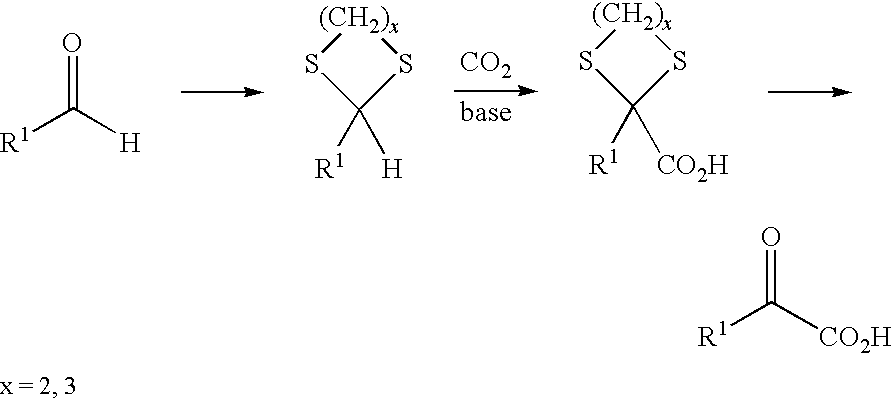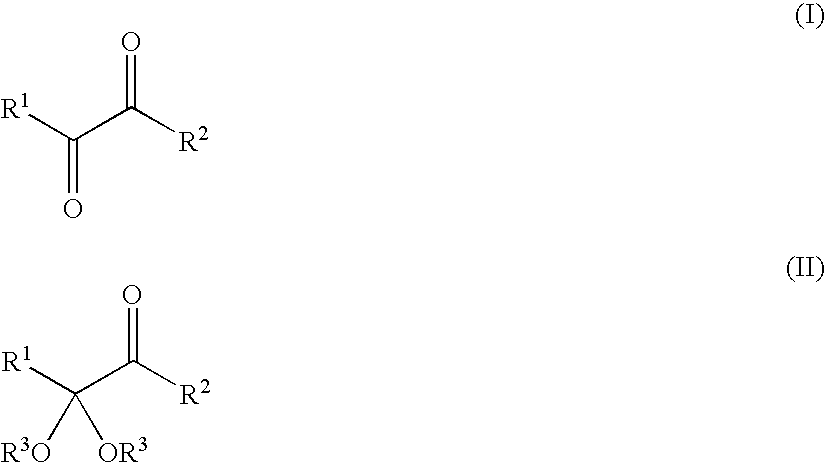Process for preparing α-keto acids and derivatives thereof
a technology of -keto acids and derivatives, which is applied in the field of preparing -keto acids, can solve the problems of high stability, inability to recycle and reuse dithiols, and high cost of suitable dithiols
- Summary
- Abstract
- Description
- Claims
- Application Information
AI Technical Summary
Benefits of technology
Problems solved by technology
Method used
Image
Examples
example 1
Preparation of 1,1,3-tris(methylthio)propane (2) from 3-(methylthio)propanal (1)
[0068]
[0069]3-(methylthio)propanal (1) (1.44 mol, 150 g) was saturated at 0° C. with HCl (g) and then added dropwise directly to MeSH (6.25 mol, 300 g) at 0° C. over a period of 30 minutes. The reaction mixture was heated to 20° C. and stirred at 20° C. for 24 h. After the excess MeSH had been removed under reduced pressure, GC analysis showed the following product distribution: 91% thioacetal (2) and 8% 3-(methylthio)propanal (1). For further purification, this mixture was dissolved in diethyl ether and washed with a 30% aqueous sodium pyrosulfite (Na2SO2O5) solution. After phase separation, the organic phase was dried over MgSO4. After the solvent had been removed, the thioacetal (2) was obtained as a pale-yellow colored oil (168 g, yield=64%, GC purity=98%).
[0070]1H NMR of 1,1,3-tris(methylthio)propane (2) (500 MHz, CDCl3): δ=2.01-2.05 (m, 2H, CH2), 2.11 (s, 9H, 3×SCH3), 2.71 (t, 3J=7.3 Hz, 2H, CH2), ...
example 2
Preparation of 1,1,3-tris(methylthio)propane (2) from acrolein (3)
[0072]
[0073]Acrolein (3) (89 mmol, 5.0 g) was added dropwise at −78° C. with stirring to MeSH (358 mmol, 17.2 g), which had been saturated with HCl gas at 0° C., over a period of 15 minutes. This mixture was heated slowly to 20° C. and then stirred further at 20° C. for 24 h. After removal of the excess MeSH under reduced pressure, this mixture was dissolved in diethyl ether and washed with a 30% aqueous sodium pyrosulfite solution. After phase separation, the organic phase was dried over MgSO4. After distillation (88° C. at 1.2 mbar), the pure thioacetal (2) was obtained as a pale-yellow colored oil (11.4 g, yield=70%, GC purity=98%). The NMR characterization gave the same data as in Example 1.
example 3
Preparation of 2,2,4-tris(methylthio)butanoic acid (4) by umpolung reaction of 1,1,3-tris(methylthio)propane (2) with dry ice (CO2)
[0074]
[0075]In a three-neck flask under a protective gas atmosphere, 1,1,3-tris(methylthio)propane (2) (3.65 g, 20 mmol) was dissolved in 50 ml of abs. THF. Subsequently, at −20° C., a butyllithium solution in n-hexane (14 ml, 1.6 M) was slowly added dropwise with stirring. In the course of this, the solution turned bright yellow. After stirring had been continued at this temperature for a further 2 h, anhydrous dry ice (CO2, 10 g) which had been washed beforehand in abs. THF was added in portions at −70° C. The reaction solution was thawed slowly to 20° C. and a 10% aqueous KOH solution (80 ml) was added. After phase separation, the organic phase was washed with 10% aqueous KOH solution (2×50 ml). The combined KOH phases were washed with diethyl ether (3×30 ml) and then adjusted cautiously to pH 1 with conc. HCl while cooling. The product was extracted ...
PUM
| Property | Measurement | Unit |
|---|---|---|
| temperature | aaaaa | aaaaa |
| temperature | aaaaa | aaaaa |
| temperature | aaaaa | aaaaa |
Abstract
Description
Claims
Application Information
 Login to View More
Login to View More - R&D
- Intellectual Property
- Life Sciences
- Materials
- Tech Scout
- Unparalleled Data Quality
- Higher Quality Content
- 60% Fewer Hallucinations
Browse by: Latest US Patents, China's latest patents, Technical Efficacy Thesaurus, Application Domain, Technology Topic, Popular Technical Reports.
© 2025 PatSnap. All rights reserved.Legal|Privacy policy|Modern Slavery Act Transparency Statement|Sitemap|About US| Contact US: help@patsnap.com



